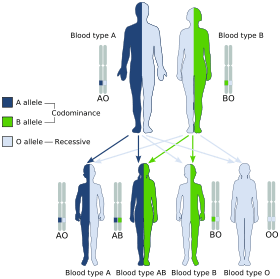Mendelian traits in humans






Mendelian traits in humans concerns how, in Mendelian inheritance, a child receiving a dominant allele from either parent will have the dominant form of the phenotypic trait or characteristic. Only those that received the recessive allele from both parents, known as zygosity, will have the recessive phenotype. Those that receive a dominant allele from one parent and a recessive allele from the other parent will have the dominant form of the trait. Purely Mendelian traits are a tiny minority of all traits, since most phenotypic traits exhibit incomplete dominance, codominance, and contributions from many genes.
The recessive phenotype may theoretically skip any number of generations, lying dormant in heterozygous "carrier" individuals until they have children with someone who also has the recessive allele and both pass it on to their child.
The human Y chromosome is composed of about 59 million base pairs and is passed virtually unchanged from father to son. The mitochondrial DNA (mtDNA) comes only from the mother and is given to both male and female children.
Examples
These traits include:
- Wet (dominant) or dry (recessive) earwax - dry is found mostly in Asians and Native Americans[2]
- Albinism (recessive)
- Brachydactyly (shortness of fingers and toes)
- Blood type
- Hereditary breast–ovarian cancer syndrome
- Hereditary nonpolyposis colorectal cancer
- HFE hereditary haemochromatosis
- Huntington's disease
- Lactase persistence (dominant)
- Leber's hereditary optic neuropathy
- Marfan syndrome
- Retinoblastoma
- Sickle-cell disease
Questionable traits
May be Mendelian but there is conflicting evidence:
- Ability to smell (bitter almond-like) hydrogen cyanide (recessive) [3]
Traits previously believed to be Mendelian
Some traits were previously believed to be Mendelian, but their inheritance is likely based on more complex genetic models, possibly involving more than one gene. These include:[4]
- Eye color
- Hair color
- Morton's toe
- Tongue rolling
- Ability to taste phenylthiocarbamide (dominant) - largely determined by a single gene, TAS2R38, with two common alleles, though there are 8 possible haplotypes[5] Because it is not a trait where the dominant tastes and the recessive cannot, but rather a continuous gradient in ability to detect PTC, it is not a real example of a simple mendelian trait. This is best exemplified by the fact that two non-tasters (recessive trait) can, in fact, have a child that can taste PTC (dominant trait).[6]
- Widow's peak (allele)
- Detached (dominant) or attached (recessive) earlobes
- Hitchhiker's thumb (recessive)
Blood group inheritance
Blood groups that children may inherit from their parents.[7][8]
| Blood group inheritance | |||||||
| Blood type | O | A | B | AB | |||
|---|---|---|---|---|---|---|---|
| Genotype | ii (OO) | IAi (AO) | IAIA (AA) | IBi (BO) | IBIB (BB) | IAIB (AB) | |
| O | ii (OO) | O OO OO OO OO |
O or A AO OO AO OO |
A AO AO AO AO |
O or B BO OO BO OO |
B BO BO BO BO |
A or B AO BO AO BO |
| A | IAi (AO) | O or A AO AO OO OO |
O or A AA AO AO OO |
A AA AA AO AO |
O, A, B or AB AB AO BO OO |
B or AB AB AB BO BO |
A, B or AB AA AB AO BO |
| IAIA (AA) | A AO AO AO AO |
A AA AO AA AO |
A AA AA AA AA |
A or AB AB AO AB AO |
AB AB AB AB AB |
A or AB AA AB AA AB | |
| B | IBi (BO) | O or B BO BO OO OO |
O, A, B or AB AB BO AO OO |
A or AB AB AB AO AO |
O or B BB BO BO OO |
B BB BB BO BO |
A, B or AB AB BB AO BO |
| IBIB (BB) | B BO BO BO BO |
B or AB AB BO AB BO |
AB AB AB AB AB |
B BB BO BB BO |
B BB BB BB BB |
B or AB AB BB AB BB | |
| AB | IAIB (AB) | A or B AO AO BO BO |
A, B or AB AA AO AB BO |
A or AB AA AA AB AB |
A, B or AB AB AO BB BO |
B or AB AB AB BB BB |
A, B, or AB AA AB AB BB |
See also
- Blood type distribution by country
- Consanguinity
- CRISPR
- DNA repair
- Electrophoresis
- Genetic disorder
- Heritability
- Human chromosomes
- Human genetic variation
- Human genetic clustering
- Human inbreeding in royal blood lines
- Punnett square
References
- 1 2 "Inheritance of Sickle Cell Anaemia"
- ↑ http://udel.edu/~mcdonald/mythearwax.html
- ↑ http://omim.org/entry/304300?search=smell%20hydrogen%20cyanide&highlight=cyanide%20smell%20hydrogen
- ↑ http://udel.edu/~mcdonald/mythintro.html
- ↑ Kim, U. K., E. Jorgenson, H. Coon, M. Leppert, N. Risch, and D. Drayna. 2003. Positional cloning of the human quantitative trait locus underlying taste sensitivity to phenylthiocarbamide. Science 299: 1221-1225
- ↑ McDonald, J.H. 2011. Myths of Human Genetics. University of Delaware. http://udel.edu/~mcdonald/mythptc.html
- ↑ "ABO inheritance patterns". Inheritance patterns of blood groups. Australian Red Cross Blood Service. Retrieved 30 October 2013.
- ↑ "ABO blood group system". Abobloodtypes.webnode.com. Retrieved 2015-02-02.
Further reading
- Mange, Elaine J.; Mange, Arthur R. (1999). Basic Human Genetics (second ed.). Sunderland (MA): Sinauer. ISBN 0-87893-497-9. Lay summary (16 October 2010).
- Speicher, Michael R.; Antonarakis, Stylianos E.; Motulsky, Arno G., eds. (2010). Vogel and Motulsky's Human Genetics: Problems and Approaches. Heidelberg: Springer Scientific. doi:10.1007/978-3-540-37654-5. ISBN 978-3-540-37653-8. Lay summary (4 September 2010).
External links
In the heterozygous condition, both alleles are expressed equally with no blending represented by using two different capital letter